Unit - 4
Biomolecules
The basic unit of life forms is the cell. All life forms consist of one or more cells for various activities. Inhumans many millions of cells are present.
The cells of all organisms consist of indivisible units of life they have four fundamental macromolecular components namely: nucleic acids (including DNA and RNA), proteins, lipids and glycans. The modification and interaction these of components results in the cell development and functions.
Each cell in the human body is minute and simple form of life. Every cell that exists in the body is programmed to do different things, such as carry oxygen, or defend the human body against viruses and bacterial infections and transmit signals to the brain. The origin of cells is linked directly to the origin of life
Since they are present in living things these building blocks are called biomolecules.
The four molecules of life are proteins, lipids, carbohydrates and nucleic acids. Each of the four groups is vital for every single organism present on Earth. Without any of these four molecules, a cell and organism would not exist. All of the four molecules of life are important either functionally or structurally for cells and, in most cases, they are important in both ways.
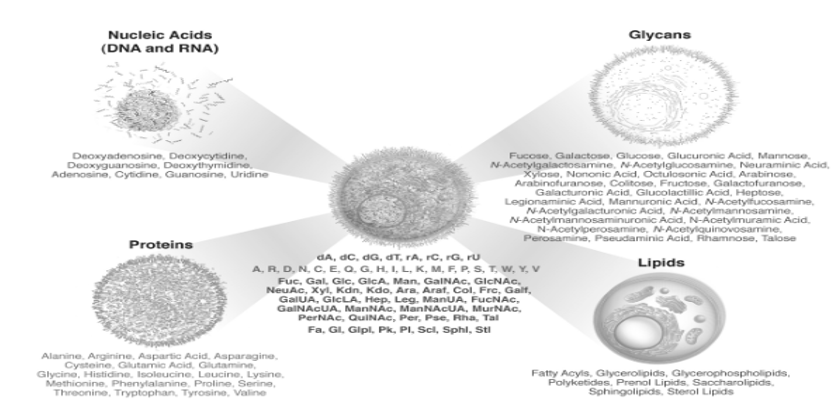
Fig: 1 The four molecules of life are proteins, lipids, carbohydrates and nucleic acids. Each of the four groups is vital for every single organism present on Earth. Without any of these four molecules, a cell and organism would not exist.
A monomer is the basic unit that chemically binds to other molecules to form a long chain called as the polymer. In case of proteins, the monomers are amino acids. for lipids, the monomers include glycerol and fatty acids for nucleic acids, the monomers are nucleotides which is made of a nitrogenous base, a pentose sugar and a phosphate group. The function of a monomeric structural unit is defined as the number of covalent bonds that are formed with other reactants. For a linear polymer chain, the structural unit segment forms two bonds and is therefore it is bifunctional. A long chain is usually formed as the monomer is a type of molecule that is capable of chemically bonding with other molecules to form a long chain; a polymer is a long chain consisting of unspecified number of monomers. Essentially, in polymers, monomers are the building blocks, and polymers are more complex type of molecules. Monomers—repeating molecular units—are connected into polymers by bonds that are called as covalent bonds
The word monomer is derived from mono- (one) and -mer (part). Monomers are small molecules which are bound closely together in a repeating manner to form more complex molecules called polymers. Monomers form polymers by forming chemical bonds or binding molecules through a process called polymerization. One of the most abundant natural polymers is Glucose, which polymerizes by forming glycosidic bonds.

A polymer is derived from (Greek poly "many" + mer, "part") is a large molecule, or macromolecule, composed of several repeated subunits. In daily life the synthetic and natural polymers play a very important role that may be specific in nature due to their broad range of properties. The synthetic and natural polymers are formed by polymerisation of many smaller molecules known as monomers, the Polymers range from natural biopolymers such as DNA and proteins that are fundamental to biological structure and function and genetic transfer to synthetic plastics such as polystyrene. The polymers have a large molecular mass, and relatively are small molecule compounds, therefore they produce unique physical properties that are used for various purposes including toughness, viscoelasticity, and a specific tendency to form glasses and semi crystalline structures rather than crystals. Polymers are studied widely in the fields of macromolecular science and biophysics, and polymer science. Historically, when observed the products that arise from the linkage of repeating units bound by covalent chemical bonds have been the primary focus of polymer science; this is emerging as the important areas of science that now focuses on non-covalent links. Polyisoprene obtained from latex rubber is a fine example of a biological polymers, and a good example of synthetic polymer is polystyrene of Styrofoam. In biological contexts, essentially all biological macromolecules—i.e., proteins (polyamides), nucleic acids (polynucleotides), and polysaccharides—are purely polymeric in nature.
In chemical terms, “sugar” usually refers to all carbohydrates with the general formula Cn(H2O)n. Sucrose is a disaccharide molecule, or double sugar, thatis composed of one molecule of glucose linked to one molecule of fructose. As one molecule of water (H2O) is lost in the condensation reaction linking glucose to fructose, sucrose is represented by the formula C12H22O11 (following the general formula Cn[H2O]n - 1).
Sucrose is predominantly present in all plants, but is known to occurat high concentrations that is sufficient for economic recovery only in sugarcane , it is a sweet crystallizable material that consists essentially or wholly of sucrose, is colourless or white when it is in pure and tends to be brown when less refined, is obtained commercially from sugarcane or sugar beet and less extensively from palms, maples and sorghum and is important as a source of dietary carbohydrate and is also used as a sweetener and preservative fora variety of foodsand of various water-soluble compounds that differ widely in sweetness, including the monosaccharides and oligosaccharides, and typically are optically active.

Fig: 2 Sugar is a sweet crystallizable material that consists essentially or wholly of sucrose, is colourless or white when it is in pure and tends to be brown when less refined, is obtained commercially from sugarcane or sugar beet
Starch
Starch, is a granular, white, organic chemical that is produced by all green plants. Starch is a soft, white, tasteless powder that is insoluble in alcohol, cold water, or other solvents. The basic chemical formula of the starch molecule is (C6H10O5) n. Starch is a polysaccharide comprising of glucose monomers that are joined in α 1,4 linkages. The branched form of starch is amylopectin and the simplest form of starch is the linear polymer amylose.
Starch is manufactured in the green leaves of plants from the excess glucose produced during process of photosynthesis and serves as a reserve food supply for the plant. Starch is stored in chloroplasts of the cell in the form of granules and in others as storage organs in the roots of the cassava plant; the tuber of the potato; the seeds of corn, wheat, and rice and the stem pith of sago. According to the requirement, starch is broken down, in the presence of certain enzymes and water, into its constituent monomer glucose units, which diffuse from the cell to nourish the plant tissues. In humans and other animals, starch from plants is broken down into its constituent sugar molecules, which then supply energy to the tissues.
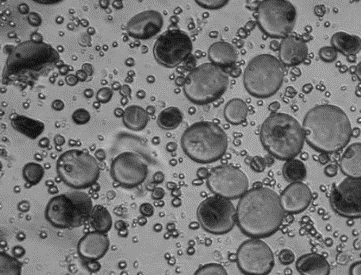
Fig 3: Starch granules present in wheat grain; the starch granules are stained with iodine.
Cellulose a complex carbohydrate, or polysaccharide, consisting of 3,000 or more glucose units. They form the basic structural component of plant cell walls; cellulose comprises about 33 percent of all vegetable matter and is the most abundant naturally occurring organic compounds. Cellulose cannot be digested by man, cellulose is a source of food for herbivorous animals (e.g., cows, horses) because they retain it long enough for digestion by microorganisms present in the alimentary tract; protozoans in the gut of insects such as termites also digest cellulose. It has great economic importance, cellulose is processed to produce papers and fibres and is chemically modified to yield substances used in the manufacture of such items as plastics, photographic films, and rayon. Other cellulose derivatives are used as thickening agents for foods adhesives, explosives, and in moisture-proof coatings.

Fig 4: shows the cellulose molecule structure, they are the basic structural units of all plant cells
Amino Acids and Proteins
Amino acids are organic compounds in nature and combine to form proteins molecules. Amino acids and proteins are the building blocks of all life forms. When proteins are broken down or digested, amino acids are left. Compared to any other class of macromolecules, Proteins are among the most abundant organic molecules in living systems and are way more diverse in structure and function. A single cell can contain thousands of proteins, each having a unique function. All proteins are made up of one or more chains of Amino acids although their structures, like their functions. Proteins can play a wide array of roles in a cell or organism. The common protein is important in the biology of many organisms (including humans). Proteins come in many different shapes and sizes. Some are globular (roughly spherical) in shape, whereas others form long, thin fibres. For example, the haemoglobin protein that carries oxygen in the blood is a globular protein, while collagen, found in the skin, is a fibrous protein.
A protein’s shape is critical to its function, and, many different types of chemical bonds may be important in maintaining this shape. Changes in temperature and pH, as well as the presence of certain chemicals, may disrupt a protein’s shape and cause it to lose functionality, a process known as denaturation.
Amino acids in simple aspect are the monomers which make up proteins. A polypeptide chain is formed when, a protein is made up of one or more linear chains of amino acids. In general, there are 20 different types of amino acids present in proteins.
Amino acids share a basic structure, which consists of a central carbon atom, also known as the alpha (α) carbon, bonded to an amino group (NH2) a carboxyl group {COOH} and a hydrogen atom.
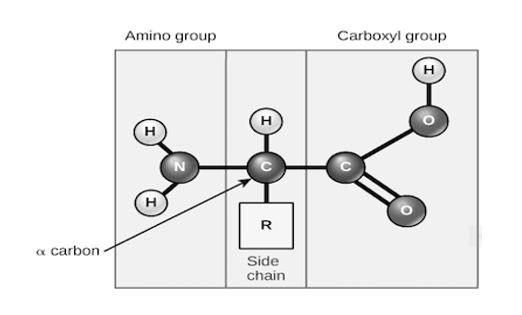
Fig 5: Basic structure of an aminoacidic, every amino acid structure also has another atom which may be present in a group or single atom that are bonded to the central atom, known as the R group, the R group is the one that determines the identity of the amino acid. For instance, if the R group is a hydrogen atom, then the amino acid glycine etc.
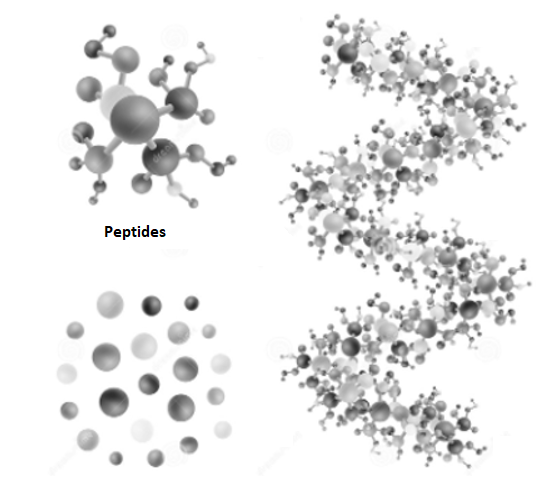
Fig 6: The pictures show Amino Acids and the compounds are bound together by peptide bonds, all proteins are made up of one or more chains of amino acids.
Nucleotide, any member or group of a class of organic compounds, that have a molecular structure that comprises a nitrogen-containing unit (base) linked to a sugar and a phosphate group. The nucleotides are of great importance to living organisms, as they form the building blocks of nucleic acids, nucleic acids are the substances that control all hereditary characteristics
In the two families of nucleic acids, Ribonucleic acid (RNA) and deoxyribonucleic acid (DNA), the sequence of nucleotides in the RNA or DNA codes for the structure of proteins synthesized in the cell. The driving force for many metabolic processes is supplied by the nucleotide adenosine triphosphate (ATP). Several nucleotides also act coenzymes; they combine with enzymes to speed up (catalyse) biochemical reactions. Nucleotide structure is simple, but the structure they can form together with other compounds is complex. Each nucleotide within has a specific structure which is shown below.
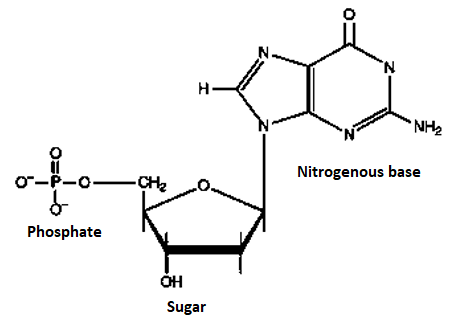
Fig 7: A nucleotide is made up of three parts: a phosphate group, a 5-carbon sugar, and a nitrogenous base
A nucleotide is an organic molecule that is the building block of DNA and RNA. They also have functions related to metabolism cell signalling, and enzyme reactions.
DNA which carries the genetic information stands for deoxyribonucleic acid, while RNA which is also involved in genetic transfer stands for ribonucleic acid. Although DNA and RNA both carry genetic information, there are quite a few differences between them. Of the two, RNA is more in nature than DNA, capable of performing enormous, diverse tasks in an organism, but DNA is more stable in nature and holds more complex information for longer periods of time.
DNA is present in the nucleus of a cell (Nuclear DNA) and in mitochondria (Mitochondrial DNA). It has two nucleotide strands which consist of its phosphate group, four nitrogen-containing nucleobases: adenine, cytosine, thymine and guanine five-carbon sugar (the stable 2-deoxyribose).
During transcription, a single-stranded, linear molecule RNA, is formed, which is complementary to DNA, helping to carry out the tasks that DNA wants it to do. Similar to DNA, RNA structure is composed of a five-carbon sugar that is less stable than Ribose and of its phosphate group, and four nitrogen-containing nucleobases: adenine, uracil (not thymine), and cytosine and guanine.
In both DNA and RNA molecules, the nucleobases are attached to their sugar-phosphate that forms the backbone of their structure. DNA has nucleotide strands on which the nucleobase is present, each nucleobase present on a nucleotide strand of DNA attaches to its partner nucleobase on a second strand: adenine always links to thymine, and cytosine links to guanine respectively. The base pairing on the opposite strands causes DNA's two strands to twist and wind around each other, resulting in a variety of shapes, such as the famous double helix (DNA's "relaxed" form), circles, and supercoils.
In RNA, uracil and adenine (not thymine) link together, while cytosine still links to guanine. Since RNA is a single stranded molecule unlike DNA which is double stranded, RNA folds in on itself to link up its nucleobases, though not all become paired. These folding subsequent forms the three-dimensional shapes, the most common one is the hairpin loop, that help determine what role the RNA molecule is to play.
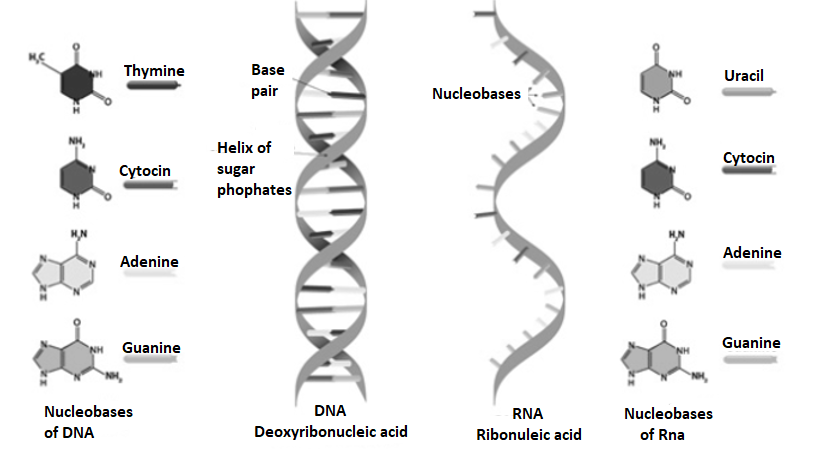
Fig 8: DNA consists of two strands, arranged in a double helix. These strands are made up of subunits called nucleotides. The bases in DNA are Thymine (‘T’) and Adenine (‘A’), Guanine (‘G’) and Cytosine (‘C’). RNA is a single strand, and the bases are Adenine and Uracil pair (A-U)
Cytosine and Guanine pair (C-G) respectively.
DNA vs. RNA – A Comparison Chart
Comparison | DNA | RNA |
Full Name | Deoxyribonucleic Acid | Ribonucleic Acid |
Function | DNA replicates and helps in storing genetic information. The special feature is it is the blueprint for all genetic information contained within an organism is stored in DNA. | The main function of RNA is that it converts the genetic information present within DNA to a format useful to build proteins, and then moves it to ribosomal protein factories. |
Structure | DNA consists is double stranded, arranged in a double helix. These strands are made up of subunits called nucleotides. Each nucleotide contains a phosphate, a nitrogenous base and a 5-carbon sugar molecule. | RNA only is single stranded, but like DNA, strand is made up of nucleotides. RNA strands are shorter than DNA strands. RNA sometimes forms a secondary double helix structure, but only occasionally. |
Length | DNA is a much longer polymer than RNA. For example, a chromosome, is a single, long DNA molecule, when the molecule is opened it would be may centimetres long in length. | RNA molecules may vary in length, but are comparatively found to be much shorter than long DNA polymers. A large RNA molecule will be a few thousand base pairs in length. |
Sugar | The sugar in DNA is deoxyribose, which contains one less hydroxyl group than RNA’s ribose. | RNA contains ribose sugar molecules, without the hydroxyl modifications of deoxyribose. |
Bases | The bases in DNA are Adenine (‘A’), Thymine (‘T’), Guanine (‘G’) and Cytosine (‘C’). | RNA shares Adenine (‘A’), Guanine (‘G’) and Cytosine (‘C’) with DNA, but contains Uracil (‘U’) rather than Thymine. |
Base Pairs | Adenine and Thymine pair (A-T) Cytosine and Guanine pair (C-G) | Adenine and Uracil pair (A-U) Cytosine and Guanine pair (C-G) |
Location | DNA is found in the nucleus, in Mitochondria with a small amount of DNA is also present. | RNA forms in the nucleolus, and then moves to specialised regions of the cytoplasm depending on the type of RNA formed. |
Reactivity | DNA is a more stable molecule than RNA. The reason being the deoxyribose sugar, has one less oxygen-containing hydroxyl group, this makes DNA a useful molecule which has the task of keeping genetic information safe. | RNA, containing a ribose sugar, is more reactive than DNA and performs enormous tasks but is not stable in alkaline conditions. RNA’s larger helical grooves mean it is more easily affected by the attack of enzymes. |
Ultraviolet (UV) Sensitivity | DNA is easily affected when the molecule is exposed to ultraviolet light and can also be damaged. | RNA is comparatively more resistant to damage from UV light than DNA. |
Acetyl CoA acts as the fuel for the citric acid cycle. This important molecule is formed from the breakdown of fats, glycogen (the storage form of glucose) and many amino acids, fats contain strings of reduced two-carbon units which are first oxidized to acetyl CoA and then completely oxidized to CO2 in the citric acid cycle.
Once inside the mitochondria, each cycle of β-oxidation, liberates a two-carbon unit (acetyl-CoA), that occurs in a sequence of four reactions: Dehydrogenation by FAD: The first step is the oxidation of the fatty acid by Acyl-CoA-Dehydrogenase. The enzyme catalyses the formation of a double bond between the C-2 and C-3.
Two carbon atoms enter the cycle in the condensation of an acetyl unit (from acetyl CoA) with oxaloacetate. Two carbon atoms leave the cycle in the form of CO 2 in the successive decarboxylations catalysed by isocitrate dehydrogenase and α-ketoglutarate dehydrogenase
Lipid, are a diverse organic group of compounds including fats, oils, hormones, and certain components of membranes that are grouped together because they do not interact well with water. The triglycerides are one type of lipids, when sequenced to form fat in adipose cells, and also serve as the energy-storage for organisms and also provide thermal insulation. Some lipids like steroid hormones serve as chemical messengers between organs, tissues and cells and other lipids communicate signals between biochemical systems inside a single cell. The organelles (structures present within the cell) and membranes of cells are found to be microscopically thin structures formed from two layers of phospholipid molecules. Organelles and membranes of cells function to separate individual cells from their environments and to categorize the cell interior into structures that carry out special functions. So important is this compartmentalizing function that membranes, and the lipids that help in forming them, must have been essential to the origin of life itself.

Fig:9 Structure of Lipid
Structure and properties of two representative lipids are shown in the picture. Both stearic acid which is a fatty acid and phosphatidylcholine which is a phospholipid, they form polar ‘heads’ and nonpolar ‘tails’ as they are composed of chemical groups. The polar heads are found to be hydrophilic, they are soluble in water, whereas the nonpolar tails are hydrophobic, they are insoluble in water. With this kind of composition in Lipid molecules they spontaneously form aggregate structures called micelles and lipid bilayers, the hydrophobic ends are however covered away from the water and the hydrophilic ends oriented toward the water.
Although biological lipids are not as large as macromolecular polymers (e.g., proteins, nucleic acids, and polysaccharides), several smaller constituents of molecules that are linked by chemical linking form lipids. Many of these molecular building blocks are homologous, in structure. The homologies allow lipids to be classified into a few major groups: cholesterol and its derivatives, fatty acids, fatty acid derivatives and lipoproteins.
References: